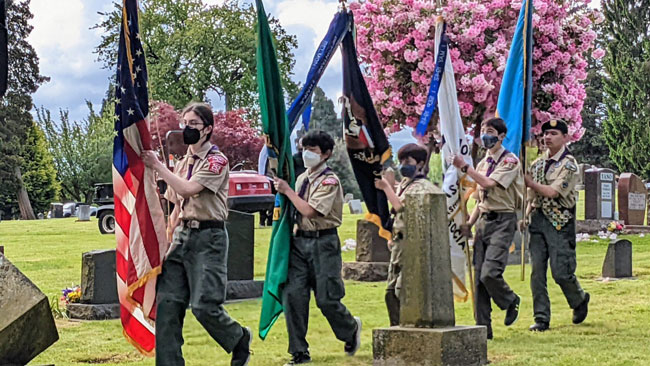By David Yamaguchi The North American Post
Photos by Arisa Nakamura Japanese Cultural & Community Center of Washington
SEATTLE — On Memorial Day, the Nisei Veterans Committee held its 77th Annual Memorial Day Service at Lakeview Cemetery, after a two-year gap owing to the COVID-19 pandemic. It was a splendid hour-long ceremony that was aided by pleasing weather after an otherwise rainy weekend. During the ceremony, the sun emerged intermittently from morning clouds, bathing attendees in bright sunlight that they had not yet become accustomed to feeling on their skin.

Among many speakers, the remarks of the following linger in the mind across succeeding days:
Colleen Fukui Sketchley (NVC Foundation) welcomed all as emcee, both veterans — who tend to attend if they are able — and non-veterans, who commonly don’t. A smooth speaker, participating in this capacity is a community service that she has done frequently across the past 16 years.

Susan Okamoto Lane, Christian Reflection speaker, introduced herself proudly as (Nisei veteran) “Tosh Okamoto’s daughter.” She “marvels at the decisions my parents made as teenagers…”
These included helping to quickly pack up family businesses and homes before their WWII incarceration (as well as her father’s joining the army at 17 and serving in its 442nd infantry).
Lt. Colonel Michael Yaguchi (USAF, ret., NVC Commander) and Geri Lynne NakaoEgeler (NVC Foundation President), also extended their welcomes and thanked all the veterans present for their service.

Yaguchi asked, “What makes this day, this ceremony, such an important part of our NVC legacy?” He continued, “We do these things to honor the loyalty, bravery, and valor of our fallen. It’s our way of honoring the American soldier of Japanese ancestry and reinforcing further that the eternal vigilance of liberty comes at a very high price. The fallen were ordinary people, who were extraordinary because of their service and ultimate sacrifice…”
Steve Hobbs (Guest speaker, Washington Secretary of State) spoke of his fellow infantry friend, Patrick Cunningham, who didn’t return from Iraq. Cunningham had been Security Officer Hobbs’ aide, doing the essential work of filing reports in which organization and attention to detail matter. This made Cunningham the man for the job, and so he did it, despite hating it. However, when away from his desk, his heart was in cooking. On Fridays, he would cook for the men. Yet, he was killed in Bagdad with only 5-6 months left in his overseas service and with a restaurant job already lined up for his return to the US. He was one of 155 Washingtonians killed in Iraq.
Death in war is like that, Hobbs ex-plained. It is sudden and near-random. Cunningham had dreamed of opening his own restaurant.
Turning to Japanese American veterans, Hobbs remarked, “I have met many Nisei veterans over the years and sadly, they are getting fewer and fewer.”
Hobbs then directed the audience’s attention to Kim Muramoto, the sole Nisei veteran present. Of Muramoto, he said, “Just Google his name and his story will come up.” (There, the NVC Speaker Series describes him among those who climbed the mountain in Italy, where the 442nd broke through the German Gothic Line.)
Muramoto was wearing a cross that is now called the French Legion of Honor. It was personally presented to him by the French Consul General for his military service to free France during WWII. All US soldiers who served in France then received this award.
On attending this community gathering, the occasional visitor feels the hands of Father Time. Wasn’t it only recently that Nisei veterans filled two rows of chairs under the audience canopy? Nonetheless, it is impressive to see younger generations taking charge. Even here, however, seeing normally jean-clad Sansei men in suits makes clear how much they now resemble their fathers.

On the brighter side was the abundant presence of women in leadership roles at the podium — a trend that started over 20 year ago — or rep-resenting or co-representing the 15 organizations that took the time to come and present wreaths. Here, Rev. Karen Yokota Love (Blaine Methodist) helped set the tone early with her invocation.
Throughout, one also had to admire the participating youth. Brandon Izutsu’s national anthem was excellent. Troop 252 scout Alexander Bertelsen played such a stellar “Taps” on his bugle from behind the audience seating area that this listener first thought it was a recording.
All told, observers can find much to like in the ceremony, organized by Bob Kiga for 16 years, and all of its participants. That five clergy, both Christian and Buddhist, each played a role says much about the esteem with which local deceased veterans are held. The Issei, resting below or looking down from above, would be proud.
A new perspective on this NVC Memorial Day Service is that it is a meaningful and safe outdoor spring outing in these pandemic times.
Sansei, in particular, can now see the event through a more mature lens. We have a deeper appreciation of the service of local JA veterans, aided by better documentation of what they have done for the country and for us. Our view is tempered by the perspective that comes from our own aging.








